The Microwave Oven Market size is estimated at USD 17.78 billion in 2024, and is expected to reach USD 22.26 billion by 2029, growing at a CAGR of greater than 4.60% during the forecast period (2024-2029).
The rising standard of living of customers, an increasing number of nuclear families, and surging demand for frozen and ready-to-eat food are key factors driving the market growth. The increasing number of working women and the preoccupied schedules of people in urban cities are likely to fuel the demand for ovens. The robust growth of the hospitality sector and rising catering contracts for large-scale functions, seminars, and other social gatherings are also expected to drive the demand for commercial appliances over the forecast period.
Economic factors, such as the rising population, increasing disposable income of consumers, and growing awareness about different cooking appliances, such as microwave ovens, grills, and barbeques, are projected to impact the market positively. The convection segment of the market is poised to account for half of the overall market.
The demand for a microwave oven may gain strong support from the rising consumer spending on kitchen appliances. The adoption of kitchen and home appliances is forecast to witness robust growth, owing to the increasing rate of urbanization. High power consumption is expected to be a dominant restraint for the growth of the microwave oven market. However, several companies are expected to develop products that consume less energy and offer a more significant advantage over their traditional counterparts.
The rising trend of connectivity between home appliances and innovations, such as inverter-based microwave ovens, is projected to create new opportunities in the market. The steady growth of sales of smart kitchen appliances is also an opportunity for the market players. Post-COVID, the microwave oven market has experienced a significant boost in sales due to increased home cooking and convenience.
This product will be delivered within 2 business days.
The rising standard of living of customers, an increasing number of nuclear families, and surging demand for frozen and ready-to-eat food are key factors driving the market growth. The increasing number of working women and the preoccupied schedules of people in urban cities are likely to fuel the demand for ovens. The robust growth of the hospitality sector and rising catering contracts for large-scale functions, seminars, and other social gatherings are also expected to drive the demand for commercial appliances over the forecast period.
Economic factors, such as the rising population, increasing disposable income of consumers, and growing awareness about different cooking appliances, such as microwave ovens, grills, and barbeques, are projected to impact the market positively. The convection segment of the market is poised to account for half of the overall market.
The demand for a microwave oven may gain strong support from the rising consumer spending on kitchen appliances. The adoption of kitchen and home appliances is forecast to witness robust growth, owing to the increasing rate of urbanization. High power consumption is expected to be a dominant restraint for the growth of the microwave oven market. However, several companies are expected to develop products that consume less energy and offer a more significant advantage over their traditional counterparts.
The rising trend of connectivity between home appliances and innovations, such as inverter-based microwave ovens, is projected to create new opportunities in the market. The steady growth of sales of smart kitchen appliances is also an opportunity for the market players. Post-COVID, the microwave oven market has experienced a significant boost in sales due to increased home cooking and convenience.
Microwave Oven Market Trends
Residential Application is Dominating the Market
In the case of the residential application segment, the most significant driver is the changing lifestyles and food consumption preferences of people, with more consumers shifting toward ready-to-eat and frozen food products. In the previous year, the residential application segment accounted for a large revenue share, and it is likely to expand at a healthy CAGR over the forecast period. A large part of new households comprises working singles who prefer to dine out rather than set up their kitchens. This may be a drawback for the residential segment of the market. However, this trend is estimated to boost the culture of quick-service restaurants, cafes, and small eateries, which, in turn, is expected to work in favor of the market.Asia-Pacific is Expected to Witness the Highest Growth
Traditional cooking equipment is still a prominent choice among many of the population in the developed regions of Asian countries. The microwave oven industry has substantial growth prospects in the Asia-Pacific region as most sales are expected to originate from customers purchasing microwaves for the first time. The growing need for energy-efficient kitchen appliances and demand for smart appliances would have a positive impact on the market expansion.Microwave Oven Industry Overview
The microwave oven market is fragmented. The competition in the market is estimated to intensify, with innovations in new products and the presence of national and international companies. Some of the most important players in the microwave oven market are Illinois Tool Works Inc., Guangdong Galanz Enterprises Co. Ltd, Sharp Corporation, LG Electronics Inc., Electrolux AB, and Alto-Shaam Inc., among others.Additional Benefits:
- The market estimate (ME) sheet in Excel format
- 3 months of analyst support
This product will be delivered within 2 business days.
Table of Contents
1 INTRODUCTION
4 MARKET INSIGHTS AND DYNAMICS
5 MARKET SEGMENTATION
6 COMPETITIVE LANDSCAPE
Companies Mentioned (Partial List)
A selection of companies mentioned in this report includes, but is not limited to:
- Illinois Tool Works Inc
- Sharp Corporation
- Guangdong Galanz Enterprises Co. Ltd
- Whirlpool Corporation
- Electrolux AB
- LG Electronics
- Alto-Shaam Inc
- Brandt
- GE Appliances
- Moulinex (Groupe SEB)
- Breville
- Panasonic Corporation
- Samsung Electronics
- Midea Group
- Miele*
Methodology

LOADING...










